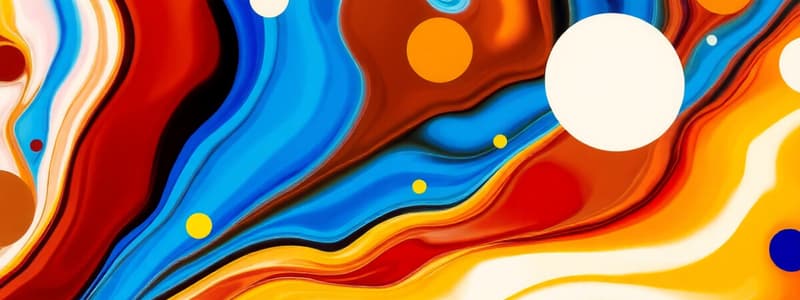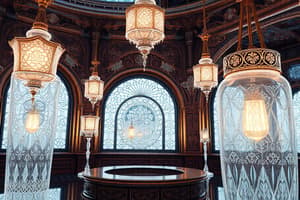Podcast
Questions and Answers
What is the primary component of glass?
What is the primary component of glass?
- Soda Ash
- Limestone
- Sugar
- Sand (correct)
At what temperature does sand need to be melted to create glass?
At what temperature does sand need to be melted to create glass?
- Over 3,000 degrees Fahrenheit (correct)
- Over 1,500 degrees Fahrenheit
- Over 200 degrees Fahrenheit
- Over 4,000 degrees Fahrenheit
Which ingredient is NOT typically included in the production of soda-lime-silica glass?
Which ingredient is NOT typically included in the production of soda-lime-silica glass?
- Natural Clay (correct)
- Soda Ash
- Calcium Carbonate
- Silicon Dioxide
What type of solid is glass classified as?
What type of solid is glass classified as?
How is plate glass created?
How is plate glass created?
What happens to sugar when it is melted?
What happens to sugar when it is melted?
Which of the following is a method used to create decorative glass?
Which of the following is a method used to create decorative glass?
What role does limestone play in glass production?
What role does limestone play in glass production?
What is frit in the context of glassmaking?
What is frit in the context of glassmaking?
Which glass-related process is particularly dangerous due to high temperatures?
Which glass-related process is particularly dangerous due to high temperatures?
Flashcards
What is glass?
What is glass?
Glass is a solid material made primarily from melted sand, or silicon dioxide, that cools and hardens into a transparent substance.
How is glass made?
How is glass made?
The process of creating glass involves heating sand to extremely high temperatures, over 3,000 degrees Fahrenheit, causing it to melt. This molten glass can then be shaped and molded into various products.
Common ingredients in glass?
Common ingredients in glass?
Soda ash is added to melt sand quicker, saving energy and production costs. Limestone strengthens the glass, resulting in a more durable product.
What is an amorphous solid?
What is an amorphous solid?
Signup and view all the flashcards
How is plate glass made?
How is plate glass made?
Signup and view all the flashcards
How are glass objects shaped?
How are glass objects shaped?
Signup and view all the flashcards
What is glass blowing?
What is glass blowing?
Signup and view all the flashcards
What is frit?
What is frit?
Signup and view all the flashcards
Different types of glass?
Different types of glass?
Signup and view all the flashcards
Why is recycling glass important?
Why is recycling glass important?
Signup and view all the flashcards
Study Notes
What is Glass?
- Glass is made from sand, specifically silicon dioxide, which has a crystalline structure
- Sand needs extremely high temperatures (over 3,000°F) to melt, unlike sugar (which melts at around 300°F)
- Molten sand, once cooled, can be shaped into various forms
- Common glass contains recycled glass, soda ash (to melt faster), and limestone (to strengthen)
How is Glass Made?
- The common glass type is called soda-lime-silica glass due to the added ingredients
- Glass is an amorphous solid, meaning it's solid but retains some liquid properties
- Unlike crystalline solids, amorphous solids lack a structured arrangement of atoms
- Molten glass can be poured onto liquid metal (like tin) for flat sheets (plate glass)
- It can be poured into molds for various shapes (drinking glasses, jars)
- Glass can be hand-blown into diverse ornate shapes
Different Types of Glass
- Artists can use frit (broken glass) to decorate or add texture. Colored frit is often employed
- Special glass types (e.g., oven-proof, crystal, bulletproof) are made with added components
- Colored/tinted glass is achieved by adding various metals (e.g., iron, chromium)
- Glass blowing creates intricate shapes using a long tube and molten glass
- Sugar imitates glass in appearance, but not in strength during breakage
Studying That Suits You
Use AI to generate personalized quizzes and flashcards to suit your learning preferences.




